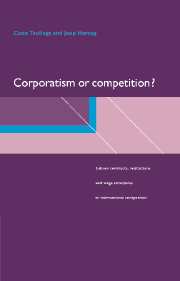 Corporatism or Competition?
Corporatism or Competition? Book contents
- Frontmatter
- Contents
- Preface
- Symbols and abbreviated references
- Synopsis
- 1 What we observe and what we claim
- 2 The role of corporatism in models of surplus sharing
- 3 Beliefs, norms and institutions
- 4 Union behaviour
- 5 Wage differentials and rent sharing
- 6 Tenure wage profiles
- 7 Unemployment and wage flexibility
- 8 Inside corporatism: how the Dutch play their game
- 9 An assessment: competition or corporatism?
- References
- Index
9 - An assessment: competition or corporatism?
Published online by Cambridge University Press: 23 November 2009
- Frontmatter
- Contents
- Preface
- Symbols and abbreviated references
- Synopsis
- 1 What we observe and what we claim
- 2 The role of corporatism in models of surplus sharing
- 3 Beliefs, norms and institutions
- 4 Union behaviour
- 5 Wage differentials and rent sharing
- 6 Tenure wage profiles
- 7 Unemployment and wage flexibility
- 8 Inside corporatism: how the Dutch play their game
- 9 An assessment: competition or corporatism?
- References
- Index
Summary
Assessing the facts
We started this book with the claim that corporatism reduces non-competitive wage differentials. It is often asserted that corporatism operates as a blunt reduction for wage inequality. While our evidence indeed shows that overall earnings inequality falls with increasing ranking on the corporatist scale, we stress that by whatever mechanism corporatism reduces wage dispersion, it certainly reduces the wage dispersion that is redundant for allocative efficiency.
We support our claim with four specimens of non-competitive wage differentials: those associated with industry affiliation, with firm size, with tenure and with the bargaining regime. We are most confident of the empirical results on interindustry wage differentials. They are widely researched and proven to be robust over time and nations. We are strongly convinced that these differentials fall with corporatism. The statistical evidence is strong and there is a direct link with the degree of centralization in bargaining and with the explicitly stated goals of wage coordination in corporatist countries. We do not feel any need for much additional research on this relationship.
About the wage effect of firm size we have little doubt either. There is much evidence that larger firms pay higher wages. Firm size is often an included variable in individual wage regressions and the result is a standard finding. But extending the international comparison would be quite welcome. Our own results cover only a subset of the countries in the sample.
- Type
- Chapter
- Information
- Corporatism or Competition?Labour Contracts, Institutions and Wage Structures in International Comparison, pp. 299 - 319Publisher: Cambridge University PressPrint publication year: 1998


